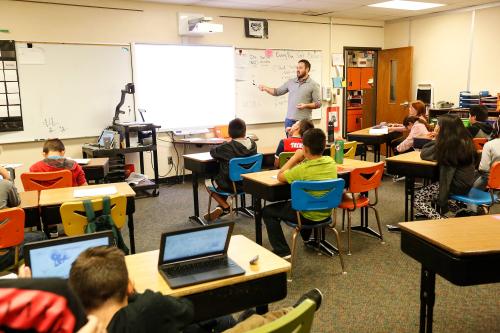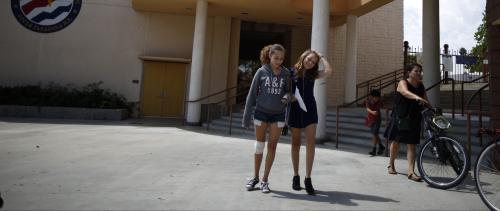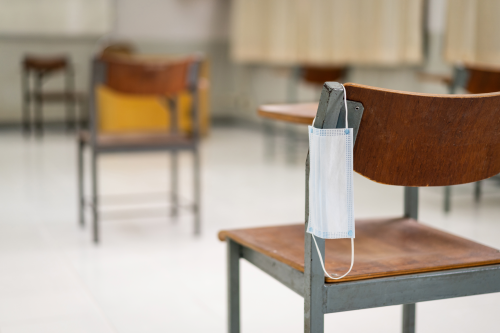Measures of chronic student absence are now taking on important policy roles across the country. The Every Student Succeeds Act (ESSA) required the adoption of non-test-based performance measures in revamped school accountability systems, with chronic absenteeism emerging as a common preferred measure. Thirty-six states plus the District of Columbia and Puerto Rico have included either chronic absenteeism or other measures of student attendance as a factor in their school-quality indicators.
Since then, chronic absenteeism has further gained attention from researchers. Our colleagues in Brookings’s Hamilton Project have put together an impressive body of work on student absences, as well as resources for policymakers on how to incorporate these measures into school accountability systems, including a recent interactive data feature on school and community factors contributing to chronic absence.
The focused attention on student absences is for good reason. About 8 million students missed at least 15 days of instruction during the 2015-16 academic year. Chronic absences put students at risk of lower test performance, disengaging from courses, and dropping out of high school.
Using chronic student absenteeism as a measure of school quality, however, could disproportionally affect schools serving low-income students due to its strong correlation with non-school factors, such as poverty and family background. Our calculations using data from the U.S. Department of Education’s Office for Civil Rights (OCR) shows chronic student absenteeism and the percentage of students eligible for subsidized lunch service (a proxy for poverty) has a correlation coefficient of 0.23 across schools. Thus, without otherwise correcting for it, using student absence measures in school accountability systems could inadvertently perpetuate the tendency to punish schools serving high-need students, one of the well-known shortcomings of No Child Left Behind that the new ESSA law was trying to correct.
Fortunately, there is a closely related measure that we believe warrants attention. In this post, we explore teacher absences, an important in-school factor that affects student learning but has received comparably little policy attention. We also discuss teacher- and school-level approaches to tackle teacher absenteeism and provide guidance for policymakers.
Teachers’ effect on student outcomes
Research has long established that teachers are the most significant school-based inputs into student learning. Empirical evidence now presents a persuasive case that teachers impact a range of student outcomes beyond test scores, including student absences, suspension rates, noncognitive skills, and college attendance.
“On average, nearly 29% of teachers were considered chronically absent (missing 10 or more school days) in the 2015-16 school year.”
Naturally, teachers need to be physically present in the classroom to provide these benefits to students. Data from the OCR, however, suggests teacher absenteeism is a concern across many schools nationwide. On average, nearly 29% of teachers were considered chronically absent (missing 10 or more school days) in the 2015-16 school year. This is nearly twice the 15% of students who are counted as chronically absent (though we should note that OCR sets a bar of 15 or more days absent for students).
When teachers miss school, substitute teachers need to be called in to cover the class. Substitutes are not nearly as effective in promoting student learning, presumably due in part to the disruption of the classroom’s instruction and the fact that substitutes are typically less-experienced instructors. For example, 10 additional days of teacher absence are associated with a decline between 1.7% to 3.3% of a standard deviation in math achievement. Further, teacher absences are costly to districts given the financial cost associated with finding and hiring substitute teachers, which accounts for roughly 1 percent of all public education spending annually. Though it may not sound like much, 1 percent of over $700 billion is not exactly pocket change.
The case for focusing on teacher absences
Despite the documented negative effects of excessive teacher absences, they have received little policy attention to date. It is not clear whether this lack of attention is due to union resistance, policymakers’ reticence to burden teachers with more scrutiny, or some other cause. Regardless, we feel teacher absences could be useful accountability measures for several reasons.
First, chronic teacher-absence rates are less strongly related to student poverty in comparison with student absence measures. Our tabulations of the OCR data show the correlation coefficient with the share of students eligible for subsidized lunch service to be 0.05. The logic here is that school accountability measures should reflect the school’s input, and teacher absences are better than student absences at signaling that input.
Second, and more importantly, teacher absences in the U.S. are notably large in comparison to other industries and countries. Though comparatively high absences among teachers have been documented previously, we suspect these rates may not be perceived as worrisome because teachers have good reasons for being absent. After all, the nature of the job entails high levels of contact with kids who get sick frequently, and the large share of women in the profession could imply teachers take more days off due to maternity leave or other household caregiving responsibilities.
Yet, our tabulation of data from the Current Population Survey suggest these reasons may not pass muster (see Figure 1). Both male and female teacher-absence rates are significantly higher than college-educated workers in other industries, including other public service occupations. (Note that we intentionally excluded summer and winter holidays to avoid overcounting teacher absences.) And nurses’ working conditions certainly expose them to sick people more frequently, yet the female nurse-absence rate is comparable to teachers and male nurses are absent about 20% less than male teachers. The data suggests absences among public school teachers are relatively elevated—and a point of leverage worth policy consideration.
Prior evidence on the topic also corroborates excessive absences among school teachers, and that a notable share of teachers’ absences appears to be discretionary. For instance, teachers are more likely to be absent on Mondays and Fridays, and a large percentage of absences due to illness tend to be next on days adjacent to weekends or holidays, or in short blocks of time that do not require medical certification.
Teacher-incentive strategies to reduce absences
The discretionary nature of absences suggests that teacher behavior could respond to different policies. For example, a study using teacher contracts from New York school districts found stronger teacher attendance was associated with certain policies like bonuses for high attendance or a sick leave buy-back program. Another analysis of New York teachers showed that teacher attendance increased during the first year of an incentive plan in which teachers could receive monetary compensation for missing less than seven days. A study of teacher absences in North Carolina concludes that a policy that simultaneously raises salaries and imposes small penalties on absences would both increase teachers’ expected incomes and lower districts’ costs.
A number of school districts have taken different approaches to address teacher absences and offer some anecdotal evidence. In Aldine Independent School District (Texas), for example, an incentive plan in which teachers with two or fewer absences can receive additional contributions to their retirement plan has helped the school district to reduce costs and increase the number of teachers with perfect attendance in a year.
Yet not all evidence is equally positive about reducing teacher absenteeism. An analysis from 40 of the largest school districts across the nation found that school districts with certain leave policies (such as paying teachers for unused leave, allowing teachers to carry over personal leave, and restricting leave on specific dates) had similar attendance rates in comparison to schools without such policies. Though we should note most of the districts in the study had in place a combination of absence-focused policies, making it hard to draw conclusions on the effectiveness of any particular policy. We take the generally positive evidence as suggesting teacher absences could respond to individual intervention aimed at changing teachers’ behavior. However, because the evidence base is still quite small, we see this as an invitation for further policy experimentation and research.
Do teacher absences signal school health?
The discussion prior to this point implicitly assumes the choice to be absent—whether because of sickness or just taking a personal day—is essentially an individual outcome. But we should also be sensitive to the role schools may play in determining teachers’ behavior. A prior study suggests that school and district policies and practices are important determinants of absences. For example, schools in which teachers experience higher levels of stress, low worker interdependence, or have an unsupportive school climate could plausibly face higher teacher absences.
Teaching is an emotionally and physically taxing job. According to the 2013 Gallup-Healthways Well-Being Index, 46% of K-12 teachers reported high daily stress. More recently, the 2017 Educator Quality of Work Life Survey showed that nearly two-thirds of teachers and school staff find their work always or often stressful. These results suggest that programs aimed at reducing teachers’ stress could be a possible mechanism to reduce teacher absenteeism.
“[P]rograms aimed at reducing teachers’ stress could be a possible mechanism to reduce teacher absenteeism.”
Interdependence between coworkers may also play a role. Prior research suggests that low worker interdependence is associated with higher absences, presumably because individuals feel their own attendance behavior does not affect their colleagues. Anecdotal evidence from schools corroborates this idea: Schools in which students from an absent teacher are assigned to other teachers in the school, rather than to a substitute teacher, may have lower absenteeism rates.
Teachers might also be inclined to miss class in schools with a lax school climate around absences. Prior research has shown absence behaviors among peer teachers affect individual absences. Yet, if principals stress the importance of attendance by building awareness among teachers and tracking absences more closely, perhaps that culture could help promote attendance.
Moving forward in addressing teacher absences
Though reducing teacher absences to zero is unrealistic and should not be the objective, designing policies to discourage the overuse of leave and providing teachers with the support they need to be in class can be a means to improve student outcomes. If we want students to treat their attendance more seriously, we should also consider policies that will encourage teachers to set the right examples for them. To our knowledge, only one state—Rhode Island—has included teacher absence measures along with student absence measures in its school accountability system.
We should note some important considerations to keep in mind when thinking about teacher absences for school accountability. First, we suspect that improvements in teacher attendance might be best addressed through a combination of “carrots” (for teachers) and “sticks” (for schools). Much of the evidence shows teachers are generally responsive to individual rewards for better attendance, so carrots could work well for the teachers. Yet, we also want to avoid situations where teachers are individually punished for legitimate absences, thus we discourage the use of punishments (i.e., the metaphorical stick) on individuals. However, given the evidence of schools’ contributions to absence behaviors, we believe sticks could be useful to apply pressure on schools.
Though more research is needed here, we suspect school-level attendance measures can flag problem spots for policymakers, indicating which schools’ climates or management practices may be contributing to mediocre outcomes. Though making schools accountable for teacher attendance should encourage school leaders to re-evaluate and improve their practices, we also caution states to carefully define what counts for an absence since that definition could create unintended consequences in schools’ hiring practices. For example, to reduce absences rates, schools could be discouraged to hire teachers with chronic health problems, which would be problematic.
Further, we also encourage policymakers and school leaders to consider the specific metrics that absence policies use as they will likely have different effects on teacher behavior. For example, holding schools to account for the average number of absence days among teachers pushes everyone to miss fewer days, while using the share of teachers whose absences exceed a given threshold should discourage teachers with excessive absences, but may not affect most teachers whose absences are more moderate. The appropriate policy levers are going to vary depending on the policy goal. We should be clear that the research evidence to date is agnostic as to which dimension of teacher attendance is most important—all studies we know linking teacher attendance to student outcomes use measures of individual absence and do not consider shares of chronic absenteeism, which is reported in the national OCR data. It may be the case that some dimensions of teacher attendance matter more than others, though we cannot say which is more important without further evidence.
“Chronically absent teachers can cause their classes to stagnate and potentially compel colleagues to work harder to pick up the slack.”
High teacher absenteeism has important consequences for students. Chronically absent teachers can cause their classes to stagnate and potentially compel colleagues to work harder to pick up the slack. Excessive teacher absenteeism is a sign that the public’s investment into public education is being underutilized, and we encourage more research and policy experimentation to gain some of the potential efficiency back.
Yuhe Gu, Grace Breazeale, and Sarah Novicoff contributed to this analysis. We thank Lauren Bauer, Michael Gottfried, and Jon Valant for helpful comments.
The Brookings Institution is committed to quality, independence, and impact.
We are supported by a diverse array of funders. In line with our values and policies, each Brookings publication represents the sole views of its author(s).










